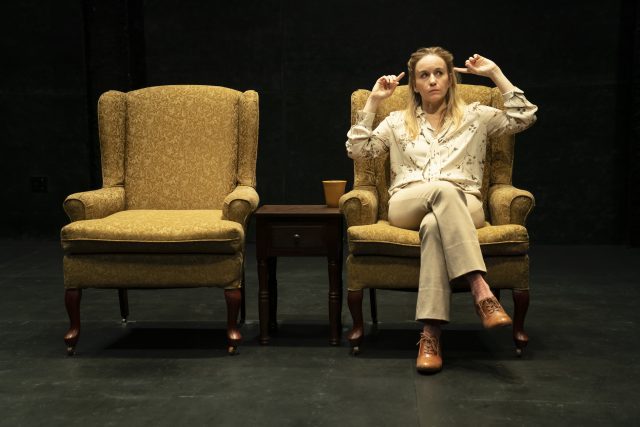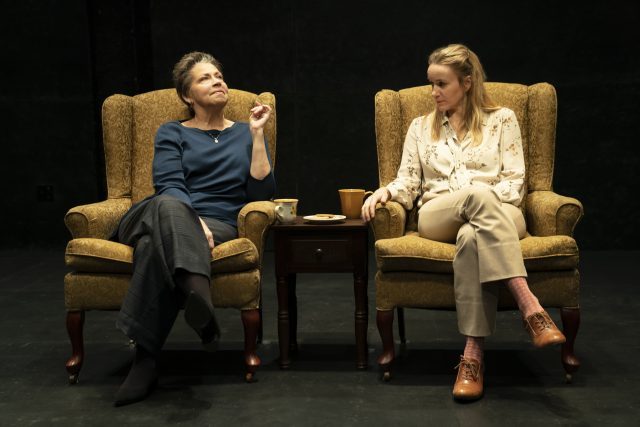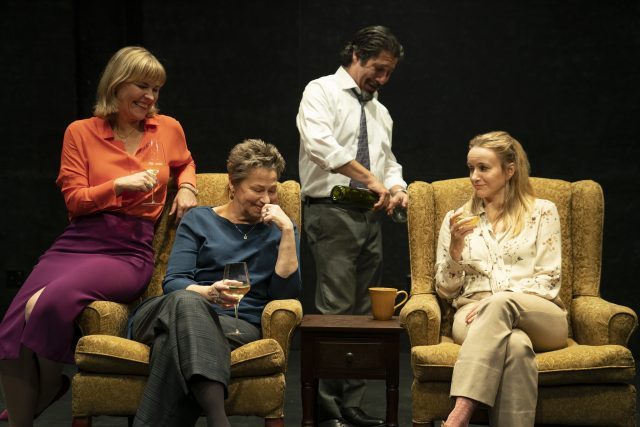
Hilda (Emily Cass McDonnell) wants to contact her deceased grandmother in New York premiere of Lucas Hnath play (photo by Joan Marcus)
Playwrights Horizons, Peter Jay Sharp Theater
416 West 42nd St. between Ninth & Tenth Aves.
Tuesday – Sunday through January 26, $59-$99
www.playwrightshorizons.org
The opening credits for the 1960s horror anthology series The Outer Limits are famous among TV aficionados: A stern voice announces, “There is nothing wrong with your television set. Do not attempt to adjust the picture. We are controlling transmission. If we wish to make it louder, we will bring up the volume. If we wish to make it softer, we will tune it to a whisper. . . . For the next hour, sit quietly and we will control all that you see and hear. We repeat: There is nothing wrong with your television set. You are about to participate in a great adventure. You are about to experience the awe and mystery which reaches from the inner mind to — the outer limits.” That statement also applies to live theater, where we sit in the dark and let cast and crew control transmission, using sound, light, costumes, architecture, dialogue, acting, and other crafts as we give up control, usually for more than an hour, and go on what we hope will be a great adventure. Florida-born playwright Lucas Hnath and British-born director Les Waters take us on such a journey in The Thin Place, which opened last night at Playwrights Horizons, where they turn the Peter Jay Sharp Theater into a haunted house worthy of The Outer Limits, The Twilight Zone, Thriller, and other classic spine-tingling tale spinners.

Linda (Randy Danson) and Hilda (Emily Cass McDonnell) become good friends in Lucas Hnath’s The Thin Place at Playwrights Horizons (photo by Joan Marcus)
Describing a party/performance he attended in Japan, the well-connected Jerry (Triney Sandoval) tells his friends Sylvia (Kelly McAndrew) and Linda (Randy Danson) and Linda’s friend Hilda (Emily Cass McDonnell), “So then at a certain point someone steps forward and begins to tell a story, a ghost story, and at the end of the story the uh teller extinguishes the candle — and then another person steps forward and tells another story, and tries to make their story even scarier than the last, and when they’re done, they extinguish another candle, and —” Sylvia cuts him off, saying, “For every candle? Jesus, sounds like torture.” What follows is not torture but delicious chills as Hilda proceeds to tell her own idiosyncratic and inexorably compelling ghost story.
Waters, the former artistic director of the Actors Theatre of Louisville, and Hnath are regular collaborators; several of Hnath’s plays have originated at that Kentucky theater. When Waters (For Peter Pan on Her 70th Birthday, Big Love) told Hnath (The Christians, A Doll’s House, Part 2) about what he calls “the thin place” — “where the line between this world and some other world is very thin” — Obie winner and Tony nominee Hnath was inspired to create a superb ninety-minute play about the power of the mind while cleverly toying with theatrical conventions. The play is narrated by Hilda, who often talks directly to the audience. Linda is an older woman who makes her living as a psychic medium, apparently communicating with the spirits of the dead. After Hilda attends one of Linda’s readings, the two women become close friends.
As a child, Hilda and her beloved grandmother would try to telepathically send words to each other, with some success. “I have no idea if it was real — was I really hearing her thoughts in the space just behind and a little above my eye?” Hilda asks. “Or was it something else. Did I just get good at guessing, guessing the kinds of words and thoughts and . . . now my grandmother — she said that what she was doing was — and my mother really would not have liked this — was that what she was doing was getting me ready for the day she died. . . . She’d be able to send words to me from beyond the grave. Just like you know how you pick up a phone and say hi how are you,” she says, evoking the Twilight Zone episode “Long Distance Call.”

Some potentially demonic topics are up for discussion at a dinner party in The Thin Place (photo by Joan Marcus)
Hilda wants Linda to help her speak again with her deceased grandmother — and perhaps find out what has happened to a missing family member. Linda brings Hilda to Sylvia’s house for a small dinner party, joined by Jerry, where they discuss Linda’s abilities. “I was thinking about it one night and it just sorta hit me that — I mean, if you look at it from the right angle — what Linda does — she grabs people’s minds — people she’s never met before, somehow she just manages to work her way in there, and people end up really trusting her,” he points out, echoing the pact we all make with creators when we enter theaters.
Danson (Arts and Leisure, Good Person of Szechuan), McAndrew (Men on Boats, Novenas for a Lost Hospital), McDonnell (The Antipodes, Mercury Fur), and Sandoval (Bernhardt/Hamlet, Marvin’s Room) are all excellent as they try to pull the wool over our eyes; Danson is warm and motherly as Linda, while McDonnell brings a spooky innocence to Hilda. Waters and Hnath are in control all the way, leading us deep into the eerie mysteries of this fantastical drama.
Mimi Lien’s effectively sparse set consists of a pair of comfy-looking armchairs that face the audience. Mark Barton’s house lights are on for much of the play, until they’re not. The show is not just a ghost story but a tale that takes place in the thin place between fiction and reality, between the living and the dead, between performer and attendee, about the things that go bump in the night — in our head and right before our eyes, what Rod Serling calls “the middle ground between light and shadow, between science and superstition, [which] lies between the pit of man’s fears and the summit of his knowledge.” Go with an open mind. But do go.